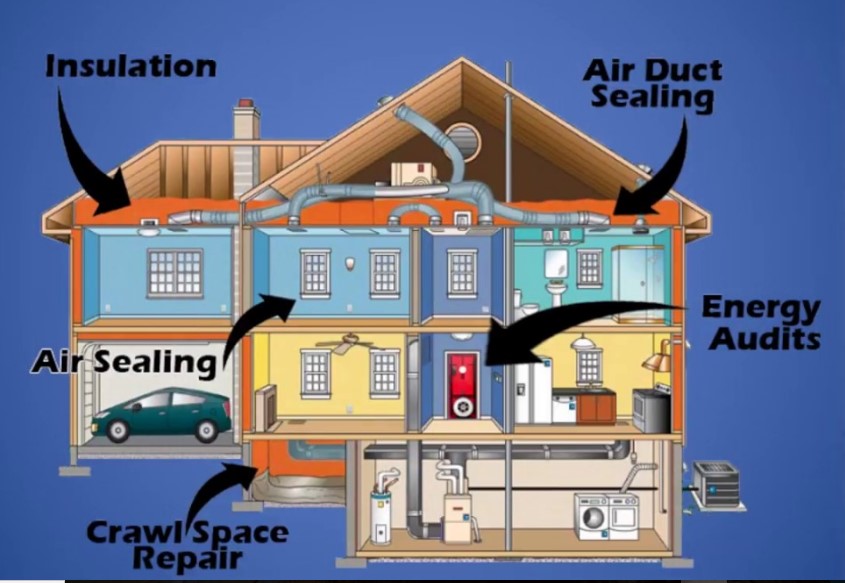Living in Cape Cod offers picturesque views and a serene environment, but the coastal climate can be a double-edged sword. The same breezes that bring in the salty sea air can also sneak into your home through gaps in windows and doors, leading to drafts, increased energy bills, and discomfort. Sealing these entry points is akin to fortifying your home’s armor against the elements. At High Efficiency Energy Solutions, we understand the unique challenges Cape Cod homeowners face and are here to guide you through effective methods to seal your windows and doors.
The Importance of Proper Sealing
Before diving into the methods, it’s essential to grasp why sealing is crucial:
- Energy Efficiency: Proper sealing prevents conditioned air from escaping and unconditioned air from entering, reducing the workload on your HVAC system and lowering energy bills.
- Comfort: Eliminating drafts ensures a consistent indoor temperature, enhancing overall comfort.
- Moisture Control: Sealing gaps prevents moisture intrusion, which can lead to mold growth and structural damage.
- Pest Prevention: Small gaps can serve as entry points for insects and rodents; sealing them keeps these unwelcome guests at bay.
Identifying Problem Areas
Think of your home as a ship; even a small leak can cause significant issues over time. Common areas where air leaks occur include:
- Window Frames: Gaps between the window frame and the wall can allow drafts.
- Door Frames: Spaces between the door and its frame are typical culprits.
- Attic Hatches: Often overlooked, these can be significant sources of air leakage.
- Baseboards: Gaps between baseboards and walls or floors can let air in.
- Electrical Outlets and Switches: Especially on exterior walls, these can be hidden sources of drafts.
Anecdote: A Cape Cod homeowner noticed a persistent draft in their living room. Upon inspection, they discovered that the decorative molding around their windows had tiny gaps, allowing cold air to seep in. Sealing these gaps made a noticeable difference in their home’s warmth.
Effective Methods for Sealing Windows
Weatherstripping:
- Types: Foam tape, V-strip, and felt are common materials.
- Application: Apply weatherstripping to the moving parts of windows to create a tight seal when closed.
- Benefits: It’s an affordable and straightforward solution that can significantly reduce drafts.
Example: Installing V-strip weatherstripping along the sides of a double-hung window can prevent air infiltration while still allowing smooth operation.
Caulking:
- Types: Silicone-based caulk is durable and flexible, making it ideal for exterior applications.
- Application: Use caulk to seal stationary components, such as where the window frame meets the wall.
- Benefits: Caulking provides a long-lasting seal against air and moisture.
Think of caulking as the mortar between bricks; it fills the gaps that would otherwise compromise the structure’s integrity.
Window Film:
- Types: Shrink film kits are readily available and easy to install.
- Application: Apply the film to the interior of windows during colder months to add an extra layer of insulation.
- Benefits: This temporary solution reduces heat loss and condensation.
A simple window film application can reduce heat loss through windows by up to 50%.
Rope Caulk:
- Application: Press rope caulk into gaps around window panes and frames.
- Benefits: It’s easy to apply and remove, making it ideal for temporary sealing.
One Cape Cod resident used rope caulk to seal the small gaps around their old wooden windows during the winter months, significantly reducing drafts without compromising the windows’ appearance.
Effective Methods for Sealing Doors
Weatherstripping:
- Types: Door sweeps, foam tape, and V-strip are commonly used.
- Application: Install door sweeps at the bottom and apply weatherstripping around the sides and top of the door frame.
- Benefits: These measures prevent air leakage while allowing the door to function normally.
A door sweep installed at the bottom of an exterior door can block cold air from entering, much like a dam holds back water.
Thresholds:
- Application: Adjust or replace door thresholds to ensure a snug fit against the bottom of the door.
- Benefits: A properly sealed threshold prevents drafts and moisture intrusion.
Think of the threshold as the door’s handshake with the floor; a firm grip keeps the cold at bay.
Caulking:
- Application: Seal gaps between the door frame and the wall with exterior-grade caulk.
- Benefits: This prevents air and moisture from penetrating the building envelope.
Sealing gaps around doors can reduce energy loss by up to 15%.
Additional Tips for Cape Cod Homes
- Regular Maintenance: Inspect seals annually and replace weatherstripping or caulk as needed.
- Professional Assessment: Consider an energy audit to identify hidden leaks and assess overall efficiency.
- High-Quality Materials: Invest in durable sealing materials that can withstand Cape Cod’s coastal climate.
- after implementing these sealing methods, a Cape Cod homeowner reported a noticeable drop in their heating bill and a significant improvement in indoor comfort.
Sealing the Deal on Energy Efficiency
- Addressing air leaks in windows and doors is one of the simplest yet most effective ways to improve energy efficiency in your home. Whether you’re tackling the job yourself with weatherstripping and caulk or seeking professional assistance for a comprehensive solution, every small step adds up to substantial savings and enhanced comfort.
- At High Efficiency Energy Solutions, we specialize in helping Cape Cod homeowners optimize their home’s insulation and sealing techniques. If you’re unsure where to begin or want expert recommendations tailored to your home, reach out to us today. A well-sealed home isn’t just an investment in energy savings—it’s an investment in year-round comfort and protection against the elements.
Take action today! Seal the gaps, save energy, and enjoy a cozier, more efficient home.









